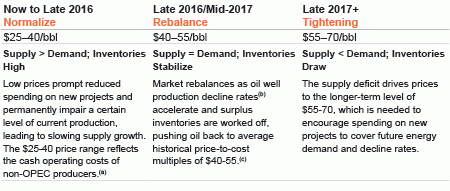Despite continued volatility, we believe the oil market is already seeing corrective actions needed for a price recovery.
We are monitoring specific milestones—capital expenditure (capex) cuts, disciplined cash flow management, falling production and inventory draws—that should ultimately balance the global oil market over three phases, gradually returning markets to a modest supply deficit and a price closer to $60 per barrel (bbl) by late 2017.
Highlights
• Our research suggests that supply cuts and modestly rising global demand could lead to sustainably higher prices toward the end of 2016, though below previous peak levels
• Using conservative assumptions for the global economy, we expect oil prices in the mid-$40s by the end of 2016 and near $60 by the end of 2017.
• Higher oil prices should have positive implications for the entire commodity asset class, as oil is both the largest component of major commodity indexes and an important input in the production of other commodities.
Drowning in Oil
Crude oil has been a defining story over the past year. The 70% plunge in oil prices from their 2014 highs has wreaked havoc on corporate earnings, adversely impacted economies and markets worldwide, diminished inflation expectations and shaped central bank monetary policies.
Three Stages to an Oil Price Recovery

The price decline has occurred not because of a precipitous reduction in demand for crude, but rather an imposing global surplus. This sea of excess oil was formed by two primary sources—the economic development of abundant U.S. reserves and the policy changes by the Organization of Petroleum Exporting Countries (OPEC).
The shale revolution in the U.S. hit its stride in 2011 as directional drilling and hydraulic fracturing (fracking) allowed companies to profitably tap oil that was locked in “tight” formations that previously would have remained untouched. In the four years that followed, U.S. oil production rose by an astounding 75%, to 9.6 million barrels per day (bpd), greatly reducing America’s need for imported oil. Increased U.S. production pushed global supply far ahead of demand, and crude oil inventories climbed to their highest levels in decades.
At the same time, Saudi Arabia and other OPEC members have continued to pump oil at near peak capacity, abandoning their traditional role in setting a floor on prices by controlling output through quotas. The reason: if they allow the oil price to fall, it will drive higher-cost production out of the market, allowing them to recapture market share lost to shale producers, primarily in the U.S.








